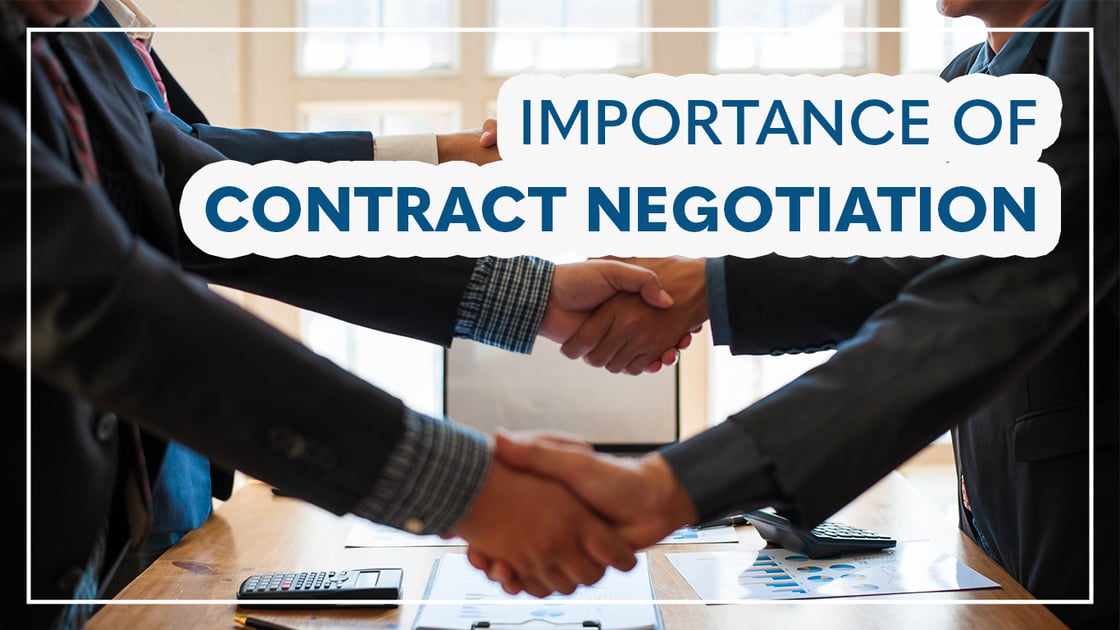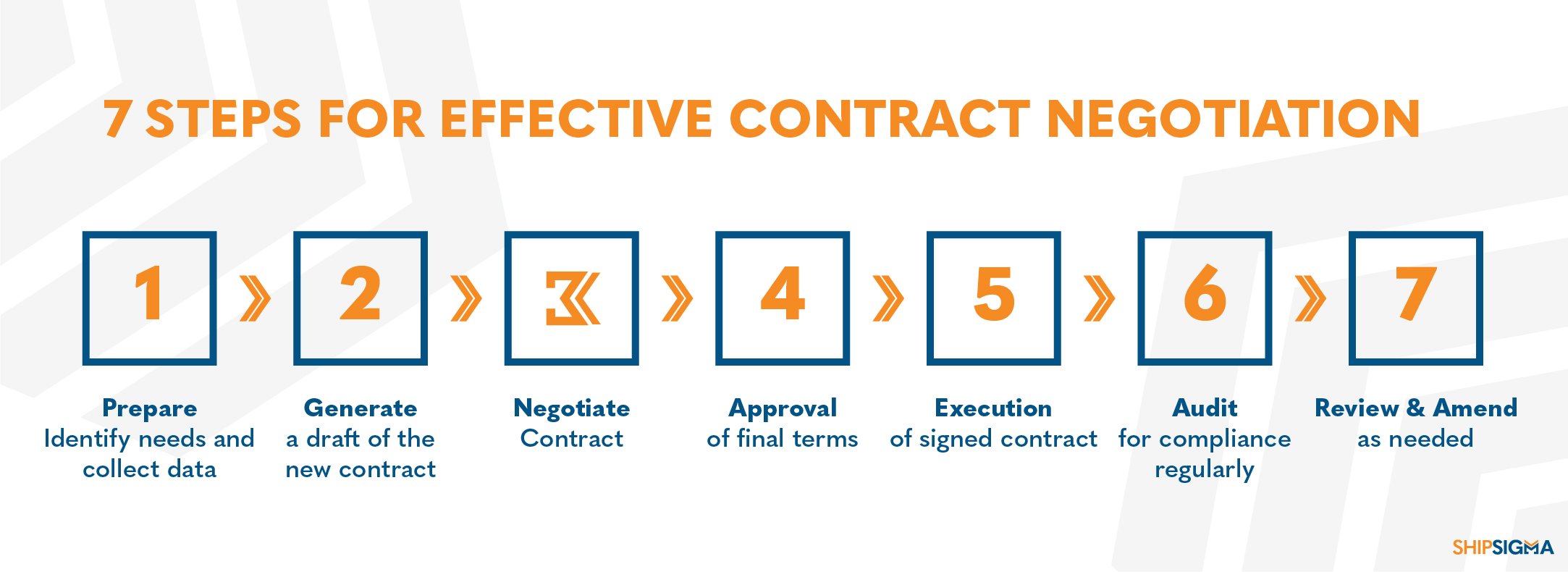The Importance of Contract Negotiation
June 29, 2022 •Chase Flashman

Contract negotiation is vital to creating mutually beneficial business relationships and decreasing conflict and confusion between parties. Without an agreed upon contract, vendors or customers could easily take advantage of each other. Typically, when negotiating contracts with vendors, the vendor will have one boilerplate contract in place for all its customers – think wedding venue. However, when it comes to parcel shipping, carrier contract negotiation is a specific type of art form due to their lack of contract standards. No two agreements look the same. In this blog, we’ll help you become negotiation experts as we discuss the negotiation objective, process, and effective negotiation strategies.
What is contract negotiation?
Contract Negotiation is the act of multiple parties coming to a legally binding agreement. Often, this process is between two parties, each seeking to achieve terms in their own favor and suffer minimal financial or legal risk. Contract negotiation is just one phase in the contract lifecycle.
Why is contract negotiation important?
The importance of contract negotiation should not be undersold. It provides clarity regarding rights, duties, prices, and expectations. It creates a sense of certainty with intentions such as quality, quantity, and ramifications for mistakes. If done right, contract negotiation can be the start of a positive long-term partnership that grows trust and strength with each year.
What is the primary objective of negotiation?
Mutual benefit. When negotiating, the end goal is for both parties to feel good about the agreed upon terms. If either party deems it necessary to take advantage of the relationship and attempt to “get the most” from the other side, the negotiation will fail. For a negotiation to be successful, all parties must believe that the contract is beneficial. This ensures the commitment to follow through on the terms.
How do you negotiate contracts effectively?
To have an effective contract negotiation, you must go through the process. Below we’ll walk you through the contract negotiation process flow chart, and touch on the importance of each step.

Prepare
Start with doing your own research for both your own company and the other party. Identify and assess your needs and requests. Establish the goals you would like to achieve in the negotiation. Then, begin researching the other party’s needs. Assess and anticipate what they will want and need throughout the negotiation process. Make sure you have data to back up your decisions, this will help you further down the line.
Generate
Generate a draft of a new contract, a list of edits you would like to see in an existing contract, or a request for a contract.
Negotiate
Begin your collaboration with the other party. Present your goals and expectations, and listen while the other party presents the same. Be flexible, but stand your ground. Having the data you collected in step one will help validate your requests. Expect a few rounds of countering here, this will likely be the longest part of your negotiation process.
Approval
Acknowledge that both parties have agreed upon the final terms and draft up a finalized contract.
Execution
To make it official, both parties must sign the new contract. Make sure the contract makes its way to the official signers, who may or may not have been in the room when the negotiation happened. Once the contract is signed, begin executing on the new standards.
Audit
Once the new contract is in full effect, begin regular audits. In these audits, check for contract compliance. Ensure both parties are fulfilling their commitment to the new contract. Run reports to track issues and successes.
Review & Amend
Begin to review the contract using the audit and changes to your business or goals as guiding pillars. If minor changes are needed, discuss amendments with the other party. As larger changes appear or the renewal date approaches, begin to prepare for another negotiation.
5 Advantages of Negotiations
1. Maximizes Value
Allows you to work up to a preferred solution that acknowledges your needs and goals, rather than blindly accepting the first offer from the vendor.
2. Strengthens vendor/customer relationship
If negotiation is done correctly, it often strengthens the relationship between the customer and the vendor due to continued open lines of communication.
3. Resolves Conflict
Once a contract is agreed upon, there is little to no room for dispute. Both parties have signed the document guaranteeing services, payment, etc. leaving no space for disagreement or conflict if one party fails to meet expectations.
4. Tailored Outcomes
Negotiation allows for custom agreements that fit the needs of each party. It allows each party to move away from the boilerplate as needed to reach the goals of both sides.
5. Increased communication
Set clear expectations and note the intended goals upfront. This allows for both parties to become more comfortable communicating their needs throughout the entire negotiation process.
5 Disadvantages of Negotiations
1. Unequal Power
Negotiation can quickly become one-sided if one of the parties does not come to the table prepared. Do your research beforehand to avoid losing the power before the negotiation begins. Remember, the party with the most information also has the greatest negotiating power.
2. Voluntary Activity
Negotiation is not a legally required mediation. It’s a choice that one party brought to the other. Because of this, either party can walk at any time. For vendors that could mean the loss of the customer, for customers that could mean the end of a long-standing relationship. To avoid being walked out on, make sure you research and understand the goals of the party. This helps mitigate the power struggle and lead the conversation to compromise.
3. Not Everything is Negotiable
Just because it’s written down, doesn’t necessarily mean it is negotiable. Be prepared to hear “no” at least once throughout the process. Keep in mind that the further divided the parties are on achieving a mutually beneficial solution, the less opportunity there is for concessions.
4. Stalling Tactics
Sometimes negotiations are used more as a distraction than for a beneficial outcome. The vendor or the customer could be stalling while waiting for an investment opportunity to go through or an original contract or clause to lapse.
5. Time
Unfortunately, negotiations are not quick. Expect it to take weeks or even months for both parties to come to an agreement they feel good about.
Why is negotiation important in procurement contract management?
Improved performance. While mutually beneficial terms are important to all negotiations, improved performance is the specific goal of negotiation in procurement. This includes meticulously defined service level agreements (SLAs) and key performance indicators (KPIs). Discussing these terms in such detail helps to alleviate future disputes regarding time, delivery, payment, and scope.
Let ShipSigma help you negotiate your carrier contract
At ShipSigma, we specialize in carrier contract negotiation and provide end-to-end execution to help you achieve the best cost reduction for your parcel shipping. We rely on $1B+ in live market data when creating your Shipping Savings Analysis that details your projected savings. We’re not here to disrupt your operations or negatively affect your relationship with your carrier. Our mission is simple, we’re here to save you money. Our customers see an average of 25.2% savings. It only takes a minute to get started. Contact us today to learn about what savings you could see with our carrier contract negotiation solution.

